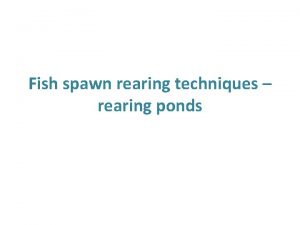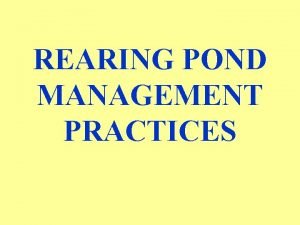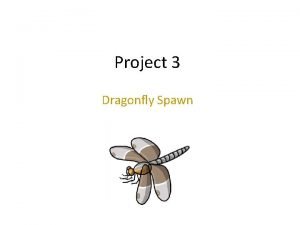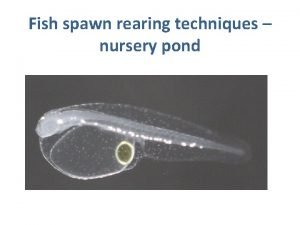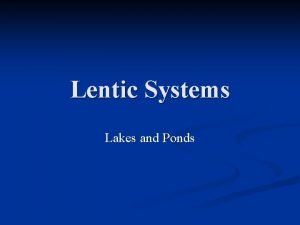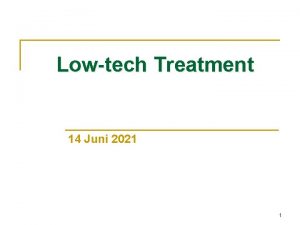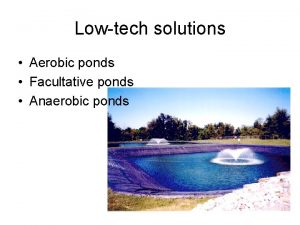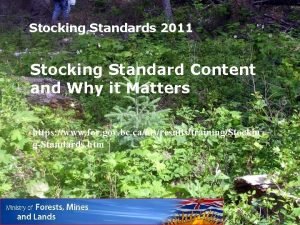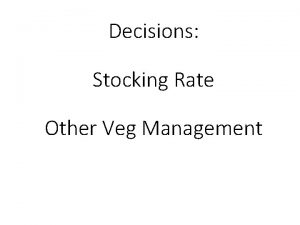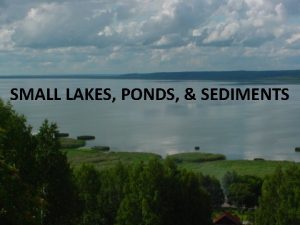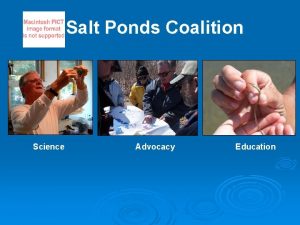Fish spawn rearing techniques rearing ponds After stocking












- Slides: 12

Fish spawn rearing techniques – rearing ponds

• After stocking- attain a length of 20 -25 mm in 15 • Artificial feeding-less than 10 % to as high as 95 -100% • The rearing ponds - second phase of carp culture • fry to fingerlings- rearing ponds • The rearing period - 2 and 3 months Figure: A series of rearing ponds Figure: A haul of carp fingerlings from a rearing pond

The management includes : (i) removal of weeds by manual/mechanical method (ii) eradication of predatory and weed fishes by netting and/or poisoning (iii) manuring with organic and inorganic fertilizers, iv) stocking with carp fry in suitable combinations and ratios, (v) supplementary feeding (vi) Harvesting

• The experiments conducted by CIFRI in various combinations of IMC and exotic carps, showed average survival of 76. 6% (range 53. 5 to 97. 4%) • The species combination -catla, rohu, mrigal and common carp; silver carp and grass carp; silver carp, grass carp and common carp • Rate of stocking - 62, 500 and 1, 25, 000 fry/ha, the number of fingerlings harvested ranges between 33, 425 and 95, 900/ha • The production value- 1, 505 -3, 486 kg/ha (av. 2, 204 kg/ha) per 3 months.

• The CIFRI – after 6 -month rearing - survival rates of 62. 1 - 98. 0% (av 78. 2%) and gross production values 755 -2, 462 kg (av. 1, 712 kg/ha/6 months) • Here, fry of grass carp, silver carp and common carp were stocked at 0. 1 -0. 25 million/ha in the ratio of 4: 3: 3 • The survival - silver carp -99%, grass carp - 80 -98% • Zooplankton - most preferred food of catla fry • The fry of rohu and mrigal accept other feeds, with silk worm pupae mustard/groundnut oil cake/rice bran/wheat bran/soybean/prawn waste • Advanced fry of catla (35 mm/2. 2 g) and rohu (45 mm/2. 9 g) recorded high survival of 84. 4 and 96. 6% and a growth of 90 mm (7. 0 g) and 117 mm (14. 7 g), respectively, in 32 days

Rearing carp seed in pens/cages • cage and pen systems • For rearing larvae, fry and fingerlings • Cages and pens - abundant supply of oxygen, flushing of metabolic wastes of the stocked fish, and nutrients from the catchment area • In India, rearing of major carp seed in pens - Bhavanisagar and the Tungabhadra reservoirs

Rearing of carp seed in pens erected in the Tungabhadra reservoir • Rearing of larvae in pens in Tungabhadra Board - one of the best managed and largest fish seed farms in south India • The main objective -nurse the delicate carp spawn in pens up to fingerling stage and then stock them in the same reservoir in order to improve the fish landings and boost the socio-economic status of fisher folk • It produced 24 t in 1954 -55 and 4, 200 t in 1981 -82 : mainly catfishes, minor carps, minnows, etc.

• An ideal site for pen erection - gentle slope with red loamy soil where water remains for a period of 2 -3 months between August and November • protected from wind and wave action • A pen is normally made up of casuarinas poles, 2 m high, fixed at intervals of about 1. 2 m, enclosing an area of 2, 000 to 5, 000 m 2 • Between the vertical poles, three horizontal rows of spilt bamboo stripes are tied to give support for the net materials

• Close mesh (monofilament nylon fabric, 30 mesh) having a width of 1. 5 m is used as the pen wall material • The bottom of the nylon fabric is inserted firmly into the mud and the vertical part securely tied to the poles and bamboo stripes • After establishment of pen, the enclosure is limed, fertilized with cattle dung and treated with soap-oil emulsion • The water in the pen is about 1. 0 -1. 2 m deep.

• The pen - stocked with three-day-old major carp larvae (4 -5 million/ha), fed with a mixture of groundnut oil cake and rice bran at a ratio of 1: 1, from a boat • Pens are periodically manured with organic and inorganic fertilizers to sustain production of zooplankton • 10, 000 kg cow dung, 400 kg urea and 100 kg superphosphate per ha, followed by repeated applications, at 10% of these rates, every two or four weeks

• Survival to 70 -80 mm fingerlings is as high as 60% after three to four months • Fishing licenses are given to local residents to uplift their socio-economic status • Advantages of pen: easy, less expensive and efficient for the nursery rearing of carp fry • Drawback: the shortage of foreshore area for large-scale pen operation.


